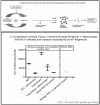A viral discovery methodology for clinical biopsy samples utilising massively parallel next generation sequencing
- PMID: 22216131
- PMCID: PMC3244418
- DOI: 10.1371/journal.pone.0028879
A viral discovery methodology for clinical biopsy samples utilising massively parallel next generation sequencing
Abstract
Here we describe a virus discovery protocol for a range of different virus genera, that can be applied to biopsy-sized tissue samples. Our viral enrichment procedure, validated using canine and human liver samples, significantly improves viral read copy number and increases the length of viral contigs that can be generated by de novo assembly. This in turn enables the Illumina next generation sequencing (NGS) platform to be used as an effective tool for viral discovery from tissue samples.
© 2011 Daly et al.
Conflict of interest statement
Figures







References
-
- Reyes GR, Kim J. Sequence-independent, single-primer amplification (SISPA) of complex DNA populations. Mol Cell Probes. 1991;5:473–481. - PubMed
Publication types
MeSH terms
Substances
Grants and funding
LinkOut - more resources
Full Text Sources
Other Literature Sources
Medical

